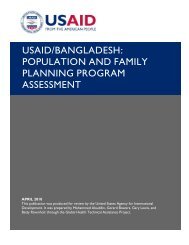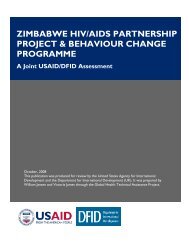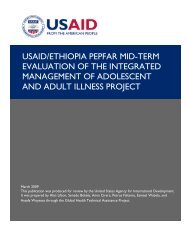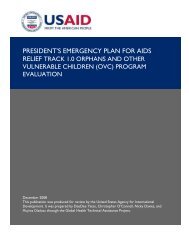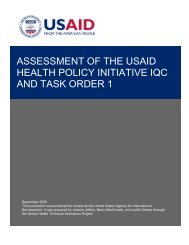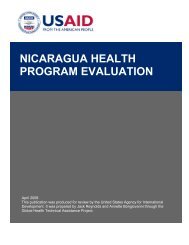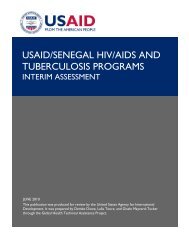Evaluation of the Tuberculosis Control Assistance Program (TB CAP)
Evaluation of the Tuberculosis Control Assistance Program (TB CAP)
Evaluation of the Tuberculosis Control Assistance Program (TB CAP)
You also want an ePaper? Increase the reach of your titles
YUMPU automatically turns print PDFs into web optimized ePapers that Google loves.
two weeks). There is a solid consensus that <strong>the</strong> <strong>TB</strong> <strong>CAP</strong> approval process is not simple enough. It <strong>of</strong>tendelays <strong>the</strong> start <strong>of</strong> work beyond <strong>the</strong> start <strong>of</strong> <strong>the</strong> fiscal year.A significant problem is <strong>the</strong> many levels <strong>of</strong> approval involved, and <strong>the</strong> delays that can occur at each. Lack<strong>of</strong> a standardized system for recording milestones in workplan development and approval makes it hard toidentify where bottlenecks most <strong>of</strong>ten occur. However, it does appear from <strong>the</strong> sampling <strong>of</strong> workplansthat long delays <strong>of</strong>ten occur at <strong>the</strong> national level due to political or o<strong>the</strong>r complexities that cannot beprepared for, such as changes in <strong>the</strong> government, which in one country delayed NTP approval by threemonths. In o<strong>the</strong>r cases, getting <strong>the</strong> Memorandum <strong>of</strong> Understanding between <strong>TB</strong> <strong>CAP</strong> and <strong>the</strong> countrysigned was cited as causing delays (in one case, almost 6 months) in <strong>TB</strong> <strong>CAP</strong> start-up.O<strong>the</strong>r long delays in workplan approval seem to be caused by a lack <strong>of</strong> involvement by key reviewers andapprovers in preparation <strong>of</strong> workplans. For example, in one country, after several weeks <strong>of</strong> preparationand agreement by <strong>the</strong> NTP and <strong>the</strong> <strong>TB</strong> <strong>CAP</strong> partner, <strong>the</strong> Mission, seeing <strong>the</strong> workplan for <strong>the</strong> first time,raised issues that required <strong>the</strong> NTP and partner to revisit it.Delays also result from a lack <strong>of</strong> information about planning and budgeting requirements, or lack <strong>of</strong> use<strong>of</strong> information available, within <strong>the</strong> Mission. In some cases, workplans approved by <strong>the</strong> Mission werechallenged by <strong>the</strong> CTO and thus needed to be clarified or adjusted by <strong>the</strong> <strong>TB</strong> <strong>CAP</strong> partner, delayingproject approval. Greater Mission understanding <strong>of</strong> what matters for CTO approval and areas wherejustification is required (for example, <strong>the</strong> number <strong>of</strong> backstopping days allowed or <strong>the</strong> reasons forchoosing an international ra<strong>the</strong>r than a national consultant) would decrease <strong>the</strong>se types <strong>of</strong> problems. Ifpossible, <strong>the</strong> draft work plan should be seen concurrently by <strong>the</strong> Mission and <strong>the</strong> <strong>TB</strong> <strong>CAP</strong> CTO.RecommendationsThe process <strong>of</strong> planning projects should be standardized and performed consistently, and approval <strong>of</strong>workplans should be streamlined.The PMU should, wherever possible, use an existing USAID/country MOU when establishing its <strong>TB</strong><strong>CAP</strong> project.If multiyear projects are introduced, <strong>TB</strong> <strong>CAP</strong> and USAID should consider how this can simplify <strong>the</strong>annual approval process.Implementing Country WorkplansIn some countries, <strong>TB</strong> <strong>CAP</strong> activities are out <strong>of</strong> phase with national priorities for <strong>TB</strong> control. In someinstances <strong>the</strong> activity or <strong>the</strong> geographic location requested is based on Mission priorities or input fromtechnical agencies, which may or may not match <strong>the</strong> needs <strong>of</strong> <strong>the</strong> national program.<strong>TB</strong> <strong>CAP</strong> has facilitated significant integration <strong>of</strong> <strong>TB</strong> into general health services, such as throughimprovements <strong>of</strong> diagnostic and drug management services that support o<strong>the</strong>r health needs and linkinghospitals with primary health facilities. However, <strong>the</strong> deterioration <strong>of</strong> primary care services and facilitiesin a number <strong>of</strong> countries in recent years makes it more difficult to provide quality diagnostic andtreatment services at <strong>the</strong> peripheral service level.There has been some progress in involving <strong>the</strong> private sector in <strong>TB</strong> control activities as a result <strong>of</strong> <strong>TB</strong><strong>CAP</strong> interventions. The dissemination <strong>of</strong> <strong>the</strong> ISTC has played a major part in this success.The coordination <strong>of</strong> planning between <strong>TB</strong> <strong>CAP</strong>, PEPFAR, CDC, and o<strong>the</strong>r country partners is seen asimproving, but it varies greatly from country to country.18 EVALUATION OF THE TUBERCULOSIS CONTROL ASSISTANCE PROGRAM (<strong>TB</strong> <strong>CAP</strong>)



